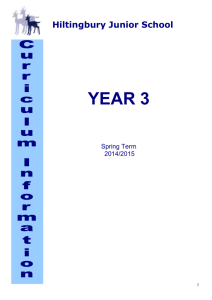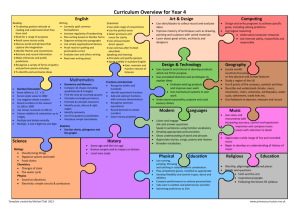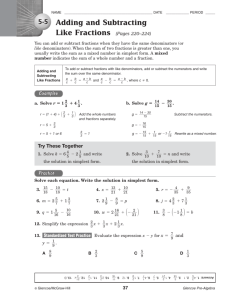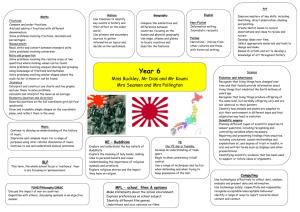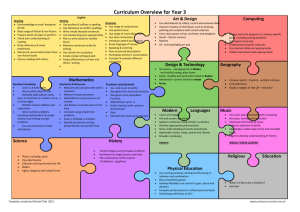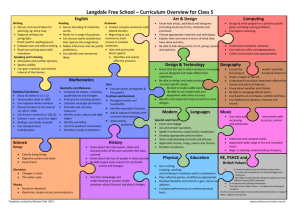YEAR 3 - Hiltingbury Junior School
advertisement
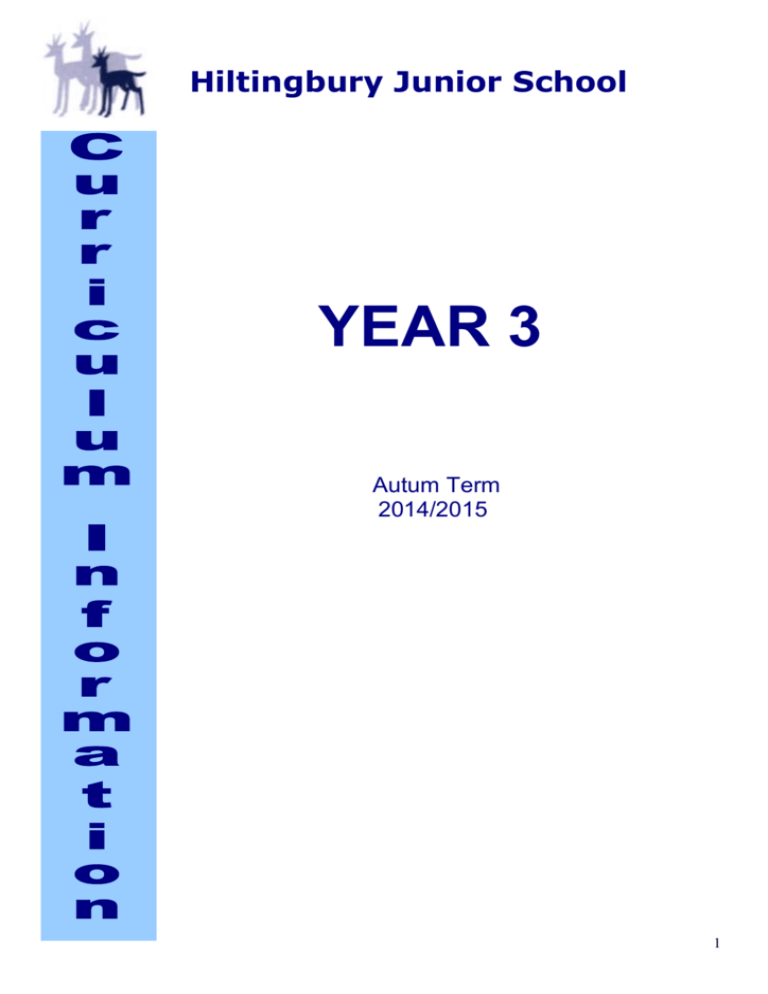
Hiltingbury Junior School YEAR 3 Autum Term 2014/2015 English English 1 English During the Autumn Term, Year 3 will be focusing on fables; leaflet writing; using our geography unit on ‘Our Place’ to provide an information leaflet for people moving into the area; shape poems based on observation and the senses; stories, using Stone Age as a stimulus and finally, non-chronological reports. A theatre company will visit the school to support our Aesops fable unit. They will show the children how to use facial expressions and body language in drama. In particular the children will learn about: Writing in sentences and using correct punctuation Story, structure and settings Different forms of poetry The format of fiction and non-fiction texts Verbs and adjectives Writing for an audience Writing instructions Using conjunctions Editing and revising their work Examples of work produced during this part of the curriculum: A non-chronological report on Hiltingbury Shape Poems A fable Stories The children have daily independent reading opportunities as well as group reading activities, which take place on a weekly basis – reading and discussing texts, expressing opinions and preferences. Children have opportunities to develop speaking and listening skills through a variety of activities, including drama in the context of English and other areas of the curriculum. Handwriting skills are taught and practised using the Nelson handwriting style. The children will have the opportunity to advance through our Master Scribe handwriting journey. On reaching scribe level, the children will be given a handwriting pen to write with. Children achieving master scribe level will be awarded a fountain pen in their house colour. Children will be learning spelling rules throughout the term; each rule will typically be worked on for a one or two-week period. Children will be required to take home up to ten words a week to learn and each child has a home spelling book where their spellings are recorded. Children will be tested weekly. 2 Mathematics Every child will take part in a daily mathematics lesson and will spend time on a range of activities and tasks, including mental maths and group work. Much of the time the class will work as one group on the same topic. This will be interactive with children explaining to each other and their teacher, what they are doing and how they are solving calculations. During the maths lesson children will have the opportunity to work in groups and learn from each other as well as solving problems on their own. The lesson will also involve lots of mental maths, as this is a vital confidence-builder for the children as they improve their numeracy. Children need to be able to do simple addition, subtraction, multiplication and division in their heads before they go on to written methods for more difficult questions. If your child can understand how to use numbers without writing them down this is a big help in all kinds of numeracy activities. Your child will learn several ways of doing mental tasks. Please don’t try to teach written methods unless you know that these methods are the ones your child is learning in school. If in doubt, check with the teacher. The daily maths lesson will help the child become strong in all the skills of numeracy. Throughout Year 3 your child will be tackling these mathematical skills: Read, write and order numbers to at least 1000; know what each digit represents Identify, represent and estimate numbers using different representations Compare and order numbers up to 1000 Count from 0 in multiples of 4, 8, 50 and 100; find 10 or 100 more or less than a given number Identify, represent and estimate numbers using different representations Add and subtract numbers mentally, including a 3-digit number and ones; a 3-digit number and tens and a 3-digit number and hundreds Add and subtract nos with up to 3 digits, using formal written methods of columnar addition and subtraction Add and subtract amounts of money to give change, using both £ and p in practical contexts Solve problems, including missing number problems, using number facts, place value, and more complex addition and subtraction Count on or back in tens or hundreds from any two or three digit number Measure, compare, add and subtract: lengths (m/cm/mm); mass (kg/g); volume/capacity (l/ml) Interpret and present data using bar charts, pictograms and tables Solve one-step and two-step questions [for example, ‘How many more?’ and ‘How many fewer?’] using information presented in scaled bar charts and pictograms and tables Recognise and show, using diagrams, equivalent fractions with small denominators Recognise, find & write fractions of a discrete set of objects: unit fractions & non-unit fractions with small denominators Recognise and use fractions as numbers: unit fractions and non-unit fractions with small denominators Compare and order unit fractions, and fractions with the same denominators Add and subtract fractions with the same denominator within one whole [for example, 5/7 + 1/7 = 6/7 ] Write and calculate mathematical statements for × and ÷ using the multiplication tables that they know, including for 2-digit nos times 1-digit nos, using mental and progressing to formal written methods Solve problems, including missing number problems, involving × and ÷, including positive integer scaling problems and correspondence problems in which n objects are connected to m objects. 3 Draw 2-D shapes and make 3-D shapes using modelling materials; recognise 3-D shapes in different orientations and describe them Recognise angles as a property of shape or a description of a turn Identify right angles, recognise that two right angles make a half-turn, three make three quarters of a turn and four a complete turn; identify whether angles are greater than or less than a right angle Tell and write the time from an analogue clock, including using Roman numerals from I to XII, and 12hour and 24-hour clocks Estimate and read time with increasing accuracy to the nearest minute; record and compare time in terms of seconds, minutes and hours; use vocabulary such as o’clock, a.m./p.m., morning, afternoon, noon and midnight Know the number of seconds in a minute and the number of days in each month, year and leap year Compare durations of events [for example to calculate the time taken by particular events or tasks]. Science Science is taught weekly in half termly units. Light – Light and Shadows The children will learn to identify a range of light sources. They will sort and classify materials by how much light they let through. They will explore what a shadow is and observe the position of the sun and a shadow changing throughout the day. Rocks and Soils During this unit we will explore how rocks are used for a variety of purposes. The children will gain an understanding about the various rock forms beneath the surface. They will observe differences and make comparisons between igneous, sedimentary and metamorphic rocks. They will understand how fossils are formed and how they provide a window to the past. The children will carry out investigations to determine the differences between rocks. They will learn that soils are formed from rocks and will observe differences and make comparisons between soil types. Geography - Our Place, Past and Present Initially, the children will gain an understanding of what geography is. They will learn about settlements and will explore the difference between a village and a town. The children will be taught what a map is and will begin to understand how and why we use symbols and keys. Using a fictional village from ‘Wallace and Gromit’ they will turn a large-scale map into a smaller version. They will understand how we fit into the wider context through exploring the location of places and environments. The children will identify and describe key physical and human features which characterise the place and will be able to express their own opintions about features in the locality. Finally, we will consider how and why places change and how they may change in the future. During the unit, we will carry out fieldwork with the children in the local Hiltingbury area. During the unit the children will be developing skills to enable them to use appropriate vocabulary and sources to describe and interpret their surroundings. The culmination of the work is an informative booklet about the local area written by the children. 4 The children will use old local maps and photos to discover changes in land use. History – Stone Age Initially in autumn 2, the children will explore what history is and will gain a chronological knowledge of key time periods in history. They will be taught the term prehistory and begin to understand the time scale of human prehistory. They will gain an understanding of what it was like for early humans and in the Palaeolithic period. The children will know about main characteristics of people and cultures that existed during the Stone Age and be able to give some reasons for particular events and changes. Art and Design We aim to develop a range of practical skills to encourage an imaginative response and a willingness to experiment with different media. The main units of work will concentrate on sketching, clay and collage. Fruit Tastic – sketching, chalk prints, sculptures Cave painting Design and Technology Children develop their designing and making skills through one main Design and Technology project each term. In each design and technology unit the children will be taught to design, make and evaluate. In the autumn term, the children will use textiles to make a tool belt that a Stone Age person may have used. Computing Initially the children will be introduced to the network and will be working on basic computer skills. We will then be focusing on word-processing skills that are taught in conjunction with the other curriculum subjects. To support our topic, ‘Our Place’, the children will learn how to use the internet to search for appropriate information. Revelation Natural Art will be used by the children to make Christmas wrapping paper. 5 In autumn 2, the children will learn about and use databases to support their learning in science and mathematics. Physical Education The children have opportunities to participate in Games, Gymnastics and Dance. Our games lessons develop the foundation for games such as netball, basketball, football, and hockey to enable them to become physically confident in a way that supports their health and fitness. We also have an orienteering unit to assist the children in familiarising themselves with the school grounds when they first arrive at the junior school. We have Gymnastics or Dance in the hall once a week. The units of work are: Healthy heart – circuit training Gymnastics - jumping and landing For all these activities children must bring to school and wear the appropriate kit. For your information lessons occur on these days: Outdoor Games – Thursdays (tracksuit bottoms can be worn during colder months and a warm fleece) Indoor PE –Tuesdays Music Pupils’ understanding and enjoyment of music is developed through activities that bring together performing, composing, listening and appraising. Children will undertake these activities within different units of work, which focus on a variety of musical skills. Fruit rap – singing in a simple round, recognising and using simple notated rythms, composing a group rap, improving the rap, performing and evaluating the rap. Rock music – recognising different combimations of layers in music, identifying a range of percussion and non-percussion instruments, identifying steps, leaps and repeated notes in melodies, beginning to understand 2,3 and 4 metre and how ryhthms fit into a steady beat, understanding dynamics and tempo Christmas Concert/Nativity Religious Education The concepts covered are: What is God like? – A consideration of the qualities of God. 6 Advent – looking at rituals and Christmas preparations. PSHE (Personal, Social & Health Education) Settling in - the caring classroom and co-operation, understanding that having rights requires individuals to accept a sense of personal and social responsibility, establishing the importance of pupils having positive and active roles in the diverse life of a community, Focus on feelings – developing the language of feelings, recognising feelings in different situations, being able to express feelings in different ways, recognising the impact of feelings on others The whole school will also take part in an Anti-Bullying week. French The children will be introduced to the language of French: Greetings Numbers Classroom phrases Colours Wacky Week Each term, the children will have the opportunity to choose a theme that will be the focus for their learning that week. Visits/Visitors In September, a theatre group will visit to put on a show of Aesop’s Fables. We are visiting Stonehenge, as part of our history unit on the Stone Age. During Year 3 children benefit greatly if parents are able to support their practising of spelling, reading, times tables and number bonds. 7


